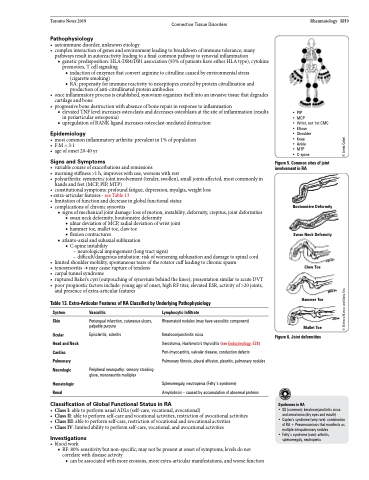Page 1295 - TNFlipTest
P. 1295
Toronto Notes 2019 Connective Tissue Disorders
Pathophysiology
• autoimmunedisorder,unknownetiology
• complexinteractionofgenesandenvironmentleadingtobreakdownofimmunetolerance;many
pathways result in autoreactivity leading to a final common pathway to synovial inflammation
■ genetic predisposition: HLA-DR4/DR1 association (93% of patients have either HLA type), cytokine
promotors, T cell signaling
◆ induction of enzymes that convert arginine to citrulline caused by environmental stress
(cigarette smoking)
◆ RA: propensity for immune reactivity to neoepitopes created by protein citrullination and
production of anti-citrullinated protein antibodies
• onceinflammatoryprocessisestablished,synoviumorganizesitselfintoaninvasivetissuethatdegrades
cartilage and bone
• progressivebonedestructionwithabsenceofbonerepairinresponsetoinflammation
■ elevated TNF level increases osteoclasts and decreases osteoblasts at the site of inflammation (results in periarticular osteopenia)
■ upregulation of RANK ligand increases osteoclast-mediated destruction
Epidemiology
• mostcommoninflammatoryarthritis:prevalentin1%ofpopulation • F:M=3:1
• ageofonset20-40yr
Signs and Symptoms
• variablecourseofexacerbationsandremissions
• morningstiffness>1h,improveswithuse,worsenswithrest
• polyarthritis:symmetricjointinvolvement(tender,swollen),smalljointsaffected,mostcommonlyin
hands and feet (MCP, PIP, MTP)
• constitutionalsymptoms:profoundfatigue,depression,myalgia,weightloss • extra-articular features - see Table 13
• limitationoffunctionanddecreaseinglobalfunctionalstatus
• complications of chronic synovitis
■ signs of mechanical joint damage: loss of motion, instability, deformity, crepitus, joint deformities ◆ swan neck deformity, boutonnière deformity
◆ ulnar deviation of MCP, radial deviation of wrist joint
◆ hammer toe, mallet toe, claw toe
◆ flexion contractures
■ atlanto-axial and subaxial subluxation
◆ C-spine instability
– neurological impingement (long tract signs)
– difficult/dangerous intubation: risk of worsening subluxation and damage to spinal cord
• limitedshouldermobility,spontaneoustearsoftherotatorcuffleadingtochronicspasm
• tenosynovitis→maycauseruptureoftendons
• carpaltunnelsyndrome
• rupturedBaker’scyst(outpouchingofsynoviumbehindtheknee);presentationsimilartoacuteDVT • poorprognosticfactorsinclude:youngageofonset,highRFtiter,elevatedESR,activityof>20joints,
and presence of extra-articular features
Table 13. Extra-Articular Features of RA Classified by Underlying Pathophysiology
Rheumatology RH9
System
Skin
Ocular
Head and Neck Cardiac Pulmonary Neurologic
Hematologic Renal
Vasculitic
Periungual infarction, cutaneous ulcers, palpable purpura
Episcleritis, scleritis
Peripheral neuropathy: sensory stocking- glove, mononeuritis multiplex
Lymphocytic Infiltrate
Rheumatoid nodules (may have vasculitic component) Keratoconjunctivitis sicca
Xerostomia, Hashimoto’s thyroiditis (see Endocrinology, E28) Peri-/myocarditis, valvular disease, conduction defects Pulmonary fibrosis, pleural effusion, pleuritis, pulmonary nodules
Splenomegaly, neutropenia (Felty’s syndrome)
Amyloidosis – caused by accumulation of abnormal proteins
• PIP
• MCP
• Wrist, not 1st CMC • Elbow
• Shoulder
• Knee
• Ankle
• MTP
• C-spine
Figure 5. Common sites of joint involvementinRA
Boutonnière Deformity
Swan Neck Deformity
Claw Toe
Hammer Toe
Mallet Toe Figure 6. Joint deformities
Syndromes in RA
• SS (common): keratoconjunctivitis sicca and xerostomia (dry eyes and mouth)
• Caplan’s syndrome (very rare): combination of RA + Pneumoconiosis that manifests as multiple intrapulmonary nodules
• Felty’s syndrome (rare): arthritis, splenomegaly, neutropenia
Classification of Global Functional Status in RA
• ClassI:abletoperformusualADLs(self-care,vocational,avocational)
• ClassII:abletoperformself-careandvocationalactivities,restrictionofavocationalactivities • ClassIII:abletoperformself-care,restrictionofvocationalandavocationalactivities
• ClassIV:limitedabilitytoperformself-care,vocational,andavocationalactivities
Investigations
• bloodwork
■ RF: 80% sensitivity but non-specific; may not be present at onset of symptoms; levels do not
correlate with disease activity
◆ can be associated with more erosions, more extra-articular manifestations, and worse function
© Elisheva Marcus and Gloria Situ © Linda Colati


